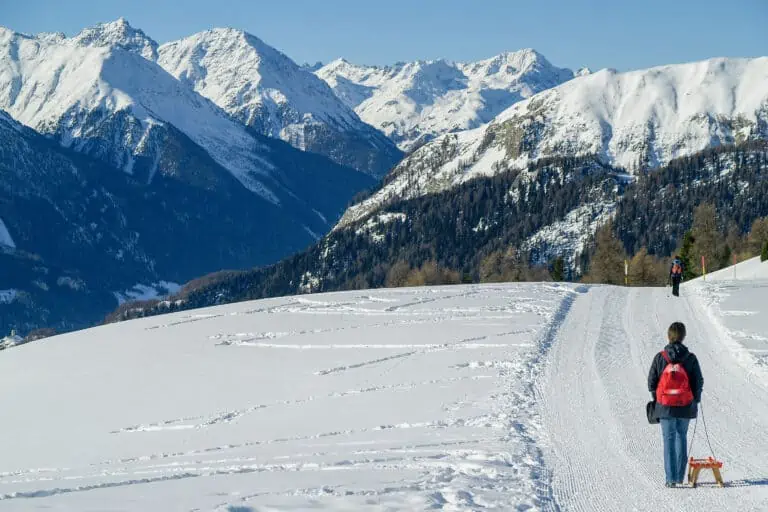Winter hiking in Switzerland: the basics
Can you hike in Switzerland in winter?
Hiking in Switzerland during winter is perfectly possible. There are many groomed winter trails. Some are very easy and flat, and even suitable for wheelchairs and prams. Others are more challenging.
Winter hiking is a great activity: you can enjoy the Swiss snow scenery in peace and quiet. And you can take wonderful pictures.
What’s the difference between winter hiking, snowshoe hiking and cross-country trekking?
- During winter hiking you’ll wear hiking boots or snowboots. You’ll walk over groomed snow trails. The easiest trails are suitable for nearly all hikers, including kids and elderly.
- Snowshoe hiking is done with flat soles, attached under your hiking boots or snowboots. You’ll also use trekking poles. Snowshoe trails run over more difficult terrain with deeper layers of snow. This type of hiking requires more stamina than normal winter hiking.
- Cross-country trekking, or cross-country skiing, is different from hiking. We provide more information here.
What’s the best time for winter hiking?
The best months for winter hiking
The best months for snow hikes in Switzerland are January, February and March. That’s when there’s most snow in the mountains.
The exact opening dates for groomed winter trails vary. They depend on weather conditions and the amount of snow. Routes at higher altitude are usually open longer than routes at lower altitude. In favorable snow conditions, the highest routes may be open from December to April.
Is snow hiking possible in summer?
Summer is not the right season for snow hikes in Switzerland. There are hardly any groomed snow trails. Regular summer hiking is the way to go.
An exception is the hike from Jungfraujoch to the Mönchjochs hut. It’s a fairly easy route with a 200 m (656 ft) altitude difference. Walking one way takes 0h45 to 1h00. It’s usually accessible from mid-March to late September or mid-October. The route can be closed if it’s exceptionally warm and if there’s a lack of snow.
Which are the best places for winter hiking?
Snow hiking in Switzerland can best be done at high altitude. There’s more snow in the mountains than in the valleys and the lower regions.
High-altitude valleys are perfect for easy snow trails. Examples are the Engadine in Graubünden, and the Upper Rhone Valley and the Matter Valley in the Valais.
Find more tips for winter destinations here.
Winter hiking and snowshoe hiking: how it works
Winter hiking on groomed winter trails
Regular winter hiking in Switzerland is a great activity for nearly everyone. You don’t need special gear, except for waterproof hiking boots or snow boots and warm clothes. Details:
- Switzerland has many prepared winter hiking trails. Snow on these trails is pushed down to a flat layer, so that you don’t sink into it. The paths are broad and safe. Still, hiking on pressed snow is tougher than on normal summer soil. That’s why a snow hike takes about 25% more time than the same distance in summer.
- Winter trails are available in several difficulty levels. The easiest routes are no longer than 5 km (3,1 mi) and have no more than a 200 m (656 ft) altitude difference.
- Snow trails are signalized by pink signs, depicting a white hiking figure.
Snowshoe hiking on prepared trails
You need snowshoes for snowshoe trails. They’re flat soles, to be attached to your hiking shoes or boots. You’ll also use trekking poles. Details:
- Snowshoe trails are prepared, signalized trails too. But the snow is not pressed down as much as on regular winter trails. There are deeper layers of snow. The flat snowshoes prevent you from sinking into the snow.
- Snowshoe hiking requires a better physical shape than regular hiking. A snowshoe hike takes about 50% more time than the same distance in summer. Since snowshoe trails aren’t groomed continually, fresh snow can make conditions harder.
- Snowshoe hiking trails come in several difficulty levels. The easiest routes are no longer than 4 km (2,5 mi) and have no more than a 200 m (656 ft) altitude difference.
- If you’re not experienced, pick short and easy routes only. You can also book a tour with a professional guide.
- Snowshoe hiking trails can be recognized by pink signs, depicting a white shoe in an oval shape.
How to prepare for snow hiking
For each hike, you should prepare well. Even if it’s a simple trail, safety is important. Study our general hiking preparation and safety tips. And pay attention to the additional warnings for winter hiking:
- Don’t underestimate hiking in the snow. It’s tougher than hiking on summer terrain. So pick shorter and easier routes than you’d do for a summer hike.
- Make sure you have the right gear.
- Don’t go winter hiking alone. Or at least make sure that someone else knows about your plans and your route.
- Check weather forecasts shortly before leaving. Don’t go out if there’s a chance of heavy snowfall or other weather dangers. Snow obstructs your view and reduces your orientation. Fresh snow can make existing trails harder to walk on.
- Walk in daylight only. Make sure you’re back well before it gets dark. During the shortest days in Switzerland, the sun starts to set at about 4:30 PM.
- Don’t leave the marked trails.
- Only hike long or high-altitude snow routes if you’re very experienced. If not, hire a guide.
Our suggestions for the best winter trails
Easy scenic winter hikes in valleys
Switzerland has many easy routes in snowy valleys. They’re suitable for nearly all hikers and offer splendid scenery. Examples of winter routes in valleys are:
- Lauterbrunnen – Stechelberg in the Lauterbrunnen Valley;
- Täsch – Zermatt and many other trails in the Matter Valley;
- many routes in the Saas Valley near Saas-Fee;
- the Lauenen valley south of Gstaad.
Many routes in the Upper and Lower Engadine and their side valleys are relatively easy and extremely scenic. Some can be combined with a horse-sleigh ride! Examples of winter trails in this area are:
- Maloja to St. Moritz;
- Pontresina to St. Moritz;
- the Morteratsch Glacier trail;
- Sils to the Fex valley;
- Bever to Spinas;
- La Punt to Cinuos-chel, called the “La-Plaiv-route“.
Easy panoramic winter hikes in the mountains
You can make easy winter hikes with amazing panoramic views in the Swiss mountains.
Many routes in the Jungfrau Region qualify. Examples of trails with difficulty levels “easy” and “medium” in this area are:
Other easy scenic winter routes in the mountains are:
- Rigi Kaltbad-Rigi Scheidegg: a broad path of 7 km (4,3 mi) with wide views of the Lake Lucerne region.
- the “Laterniweg” at Schwägalp: an easy 3 km (1,9 mi)-route lit by lots of lamps. It’s one of the few routes that are suitable for hiking in dusk.
- the hike from and to Haut-de-Caux: a 6 km (3,7 mi)-trail on the slopes of Rochers-de-Naye.
- several trails on the slopes of the Gornergrat near Zermatt, for example Rotenboden-Riffelberg: an easy 2 km (1,2 mi)-path with great views of the Matterhorn.
- Sunnegga-Tufteren above Zermatt: a quick 2 km (1,2 mi)-hike with lovely views.
- the Glacier Walk at Glacier 3000: a 2,4 km (1,5 mi)-route in a winter wonderland.
Long-distance winter hikes
Long winter hikes are available too in Switzerland. If you’re experienced and if you’re in good physical shape, you can complete routes up to 10 km in a day. Another option is hiking short stages in several days, with overnight stays in between. Examples are:
- Fiescheralp – Bettmeralp – Riederalp: a very famous 9 km (5.6 mi)-route (difficulty level “medium”) on the slopes of the Upper Rhone valley, with amazing panoramic views.
- Leukerbad – Gemmi Pass – Kandersteg: an alpine pass hike spanning roughly 10 km (6.2 mi), from the southern to the northern part of the Alps.
- Niederhorn – Waldegg: a 10 km (6.2 mi)-descent of 880 m (2887 ft) from the Niederhorn above Lake Thun to the settlement of Waldegg.
- Realp – Andermatt: a beautiful 9 km (5.6 mi)-hike along the river Reuss, also called the “Ursental trail”.
- The Via Engiadina is a long path in the Upper and Lower Engadine. You can hike several stages on multiple days. Packages with luggage transfer are offered.
Suspension bridges accessible in winter
Switzerland has many thrilling suspension bridges. Not all of them are open in winter. The ones below are (if weather is good):
- the Peak Walk suspension bridge at Glacier 3000;
- the Cliff walk at Titlis;
- the Bellwald-Mühlebach bridge in the Upper Rhone Valley;
- the Hostalden bridge south of Frutigen in the Engstligen Valley;
- the Skywalk near the Stuckli Rondo gondola station in Mostelberg, in the canton of Schwyz;
- the Carasc bridge near Carasso/Bellinzona in Ticino.
More practical winter information
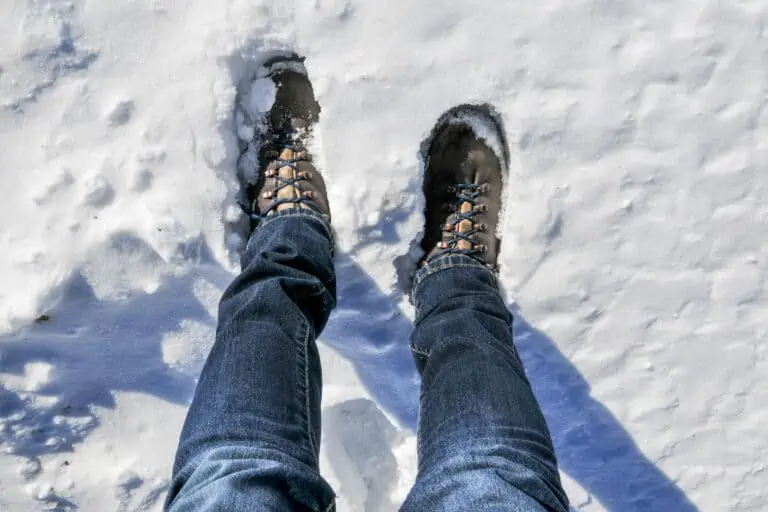
Clothing and gear
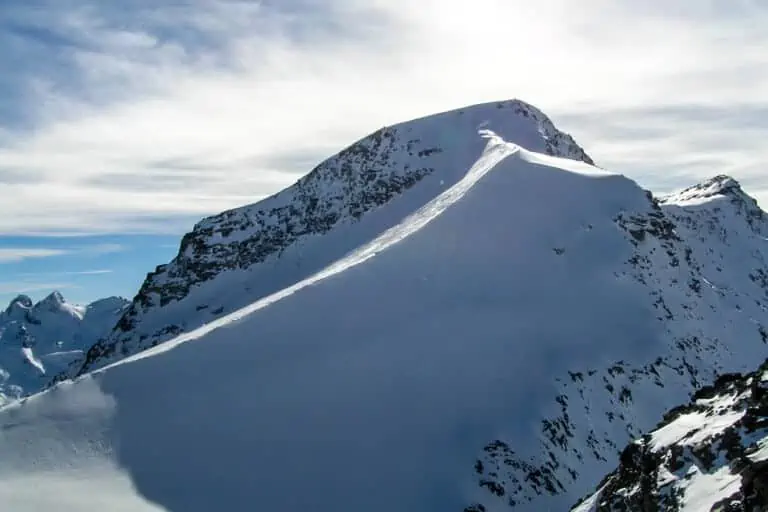
Winter activities
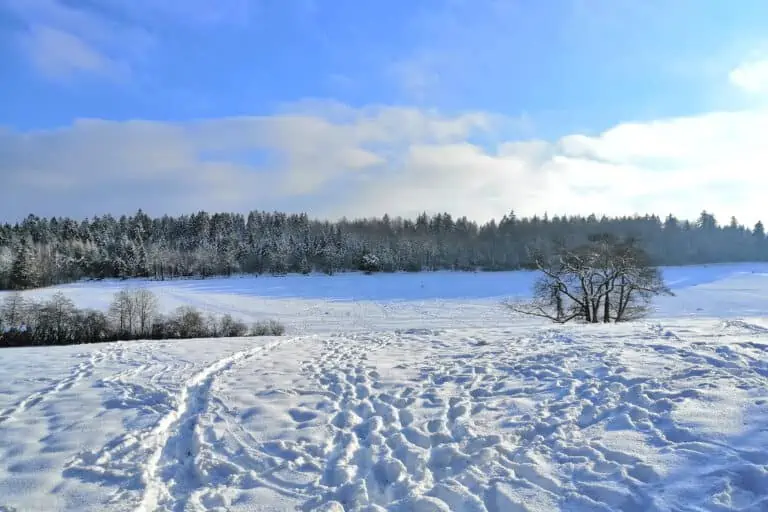
Winter weather and best time to visit
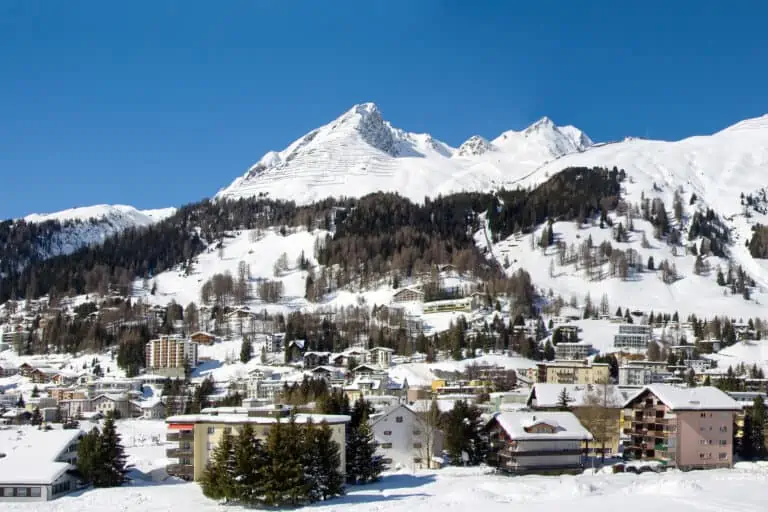
Winter towns
Other websites of interest
- www.schweizmobil.ch: winter hiking trails
- www.schweizmobil.ch: snowshoe trails
- www.schweizmobil.ch: signalization of trails, including winter hiking, snowshoe and cross-country trails
- www.haengebruecken.com: suspension bridges in Switzerland
